Three Businesses, Three Stories, Three Uses for Microfinance
May 26, 2013
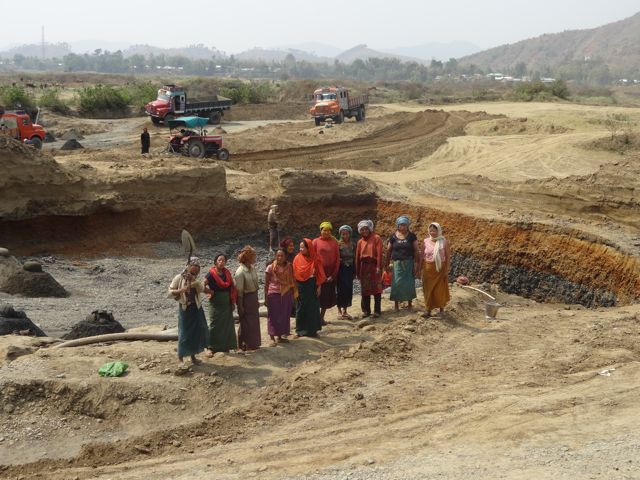
One day in Imphal, I found myself engaged in a lengthy discussion with one of my field partner's Cluster Heads. He was trying to explain to me his dedication to the organization, and why it has persisted as long as it has. He was eloquently describing to me the evidence he has gathered as proof that microfinance works.
Now, I thought I knew that microfinance works. After all, I had done research about microfinance during my graduate degree. If the books and papers say its so, it must be so!
What I’ve learned throughout my time here, though, is that sure, I may have read a book about it, but what good does a book do when you’re trying to explain to a woman why she has to repay her loan on time? What good does a book do when you’re teaching the Loan Officers that they need to fill out their Borrower Profile Interview Form correctly? What good does a book do when a borrower can’t make a payment because her daughter was in the hospital or her pig died before she could sell it for profit?
The Cluster Head was describing to me his collected evidence that microfinance is working to change these communities from the inside. He actually said something that I think a lot of people would empathize with: he misses being in the field more often. And honestly, that’s probably the thing that I’m going to miss the most about being in Manipur. Back in February, I blogged about three individual borrowers to try to illustrate what microfinance is doing for individual women within communities. Now that I’ve been going to the field for three months, having more conversations, reviewing more loan recipients and results, and seeing how the people really function, I’d like to circle back and look at the “bigger picture” of what individual businesses can and have done for the communities they serve.
The most recent business I visited was a group of women who all make local wine. There are four or five women in the particular housing complex I visited, and each has her own winemaking business. Interestingly, Manipur is a dry state; production and consumption of alcohol is technically illegal. Somehow, these local winemakers throughout the state manage to manufacture and sell wine without disruption.
I wanted to understand how these women felt about their business, both from a legal standpoint as well as from an inception standpoint. What sparked their interest in wine production? How do they manage to avoid sanctions – or worse, being shut down?
It turns out this region of the state, and more specifically, this region of this village, is known for its winemaking. Vendors come from all over, knowing that these women have the “sweet hand” for winemaking.
This isn’t just the current case, either. These women’s mothers, and their mothers, and their mothers’ mothers all brewed this local wine. It’s in their genes, ingrained in some sort of genetic muscle memory that enables them all to successfully produce a tasty brew.
I don’t know about you, but the first thing I wonder in this case is why a loan is necessary in this generation of brewers if all past generations have been able to succeed just fine without it. How is this loan to this group of women actually transforming a community? Isn’t the point of a Kiva loan to help people lift themselves out of poverty with some sort of novel idea?
Well, let’s go back to this mention of book learnin’. These women may have been serving the same function to their community by producing the same wine that previous generations had. However, with the security a loan gave them (rather than borrowing money from a money lender with significantly higher interest rates), they are given the minimal free time and free space in their otherwise stressed lives to explore other options for their futures. For example, this generation has the flexibility to consider education for their children. They can purchase mosquito nets. They can reach more clients and produce more wine to reach those clients. The Kiva loan has facilitated a potential move into a different social status with these small changes.
Another borrower group that really affected the way I have perceived microfinance is Apunba Chanura. These women sieve sand on the riverbank to sell to construction companies to use as concrete.
Again, sieving sand isn’t a new industry in Manipur; people have been manually sifting through the riverbanks’ sandy shores to separate out the different types of dirt and rocks for decades. However, I knew this group was different the second I laid eyes on their production.
The site where these women work looks like a construction zone; they have big trucks lined up, awaiting their product, men in hard hats sitting on the sidelines, piles of dirt, sand, rocks, and pebbles neatly stacked, and at least thirty people in the trenches, shoveling and sifting through the materials. I was so excited to have a chance to speak with them, and actually felt lucky to catch them. This is the first group of women that was tough to get an audience with – their schedule had simply been too busy for a fifteen-minute interview.
 The scope of sand sieving operations
The scope of sand sieving operationsAll ten members had at one time or another been employed by men who owned plots of land leased specifically for sieving sand. They worked for years for hourly wages, barely scraping by. One day, one of the women (who became the Kiva featured borrower) realized that they could minimize their workload and maximize their income if they leased their own plot of land. This is where Kiva came in. The ten women (they all knew each other from work and from the community) got together to form a group, applied for a loan from WSDS, and with the money from Kiva lenders around the world, had enough to lease a one-acre plot of land along the river for 8 months, the time it takes to fully sift through all the dirt along the riverbank.
 Two of the Kiva borrowers laughing at me for taking millions of photos like the paparazzi.
Two of the Kiva borrowers laughing at me for taking millions of photos like the paparazzi. Moreover, the ten women realized they would be able to employ men to work for them, pay them, and still make more money than they had been making before. Their success in this endeavor so far leads them to believe that next season, they won’t have to work at all but rather manage those people working on their plot of land, giving them more time for household activities and other income-generating activities.
Again, while this is not a new industry by any means for women in this region of Manipur, what is changing is the way the small communities are structured. These women are no longer employees, they are employers. They no longer live paycheck to paycheck on hourly wages, but rather are controlling their own income and livelihood.
Two weeks before I left Imphal, I by chance met another Kiva borrower. I had gone with the two loan officers to do a group training at a center two blocks from the Head Office. This group’s center was a Tea Hotel, owned and operated by a Kiva borrower! I was so excited to learn that one of the borrowers was in Imphal itself, and running a fully-functioning business that I insisted on setting up a time to come visit her and talk to her about her Hotel.
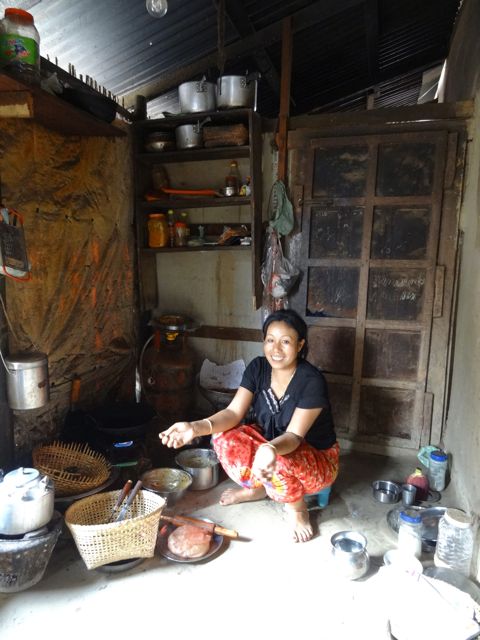 Leishembi runs a Tea Hotel out of her home in Imphal
Leishembi runs a Tea Hotel out of her home in ImphalWhile sipping chai and chomping on the most delicous puri, saabzhi and aloo I’ve ever had, I asked Leishembi all about her business. Why had she decided to open a tea hotel? What was it that she liked about her store? What didn’t she like? And most importantly, where did she learn to cook so unbelievably well?
In Leishembi’s opinion, the tea hotel was a no-brainer. She had some space in the front of her house, and a neighborhood full of friends and family that needed a local tea hotel for their morning food needs. Plus, did I mention she’s an amazing cook?
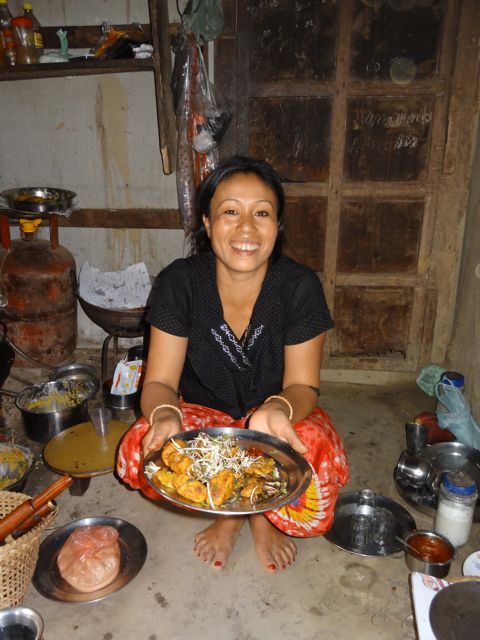 Some of Leishembi's goodies
Some of Leishembi's goodiesLeishembi’s theory of the neighborhood needing a local tea haunt quickly showed itself to be a reality. While we were there that afternoon, we saw the 8 year old boy next door come for puri for his family; we saw the 14 year old girl from down the street pick up tea for her aunties; we saw two grandfathers come buy tea and sip it across the street, sitting on crates in the sunny road. Leishembi had truly given her community a central place to come for their tea and social needs. She explained that even in the morning, all the kids came to her for breakfast before getting on their school buses. It seems the parents trusted that Leishembi could adequately fill the stomachs of their children, so they wouldn’t have to cook extra at home.
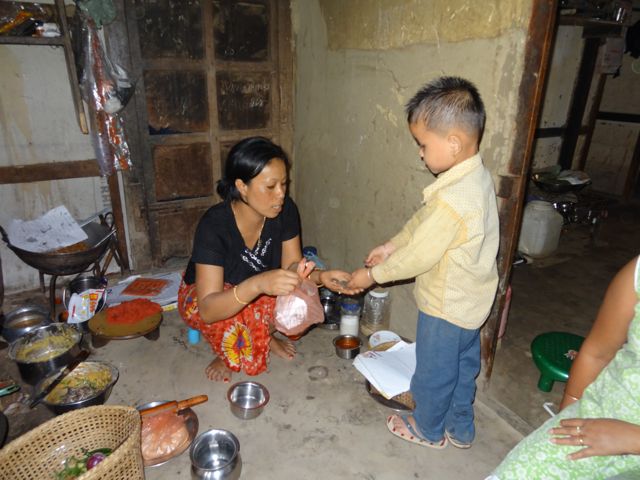
We soon learned that Leishembi was a natural leader in her community, tea hotel aside. She knew everyone in the vicinity and was well-liked and respected by all. It even turned out that WSDS’s Finance Director, a local himself, knew her and chose to bring her puri home to his family in the evenings sometimes.
This brings me to my next, very important topic: her food. Leishembi said that her favorite thing about her business was cooking. She loved being able to cook food that people enjoyed.
Now, in order to understand just how hard it is to do well with a Tea Hotel, I should explain Imphal’s Tea Hotel economy. There are tea hotels on every corner. They are like Starbucks in San Francisco or Seattle. People typically patronize the hotel that is closest to them at any given time; that is, unless there is reason to travel to a particular hotel.
As far as I’m concerned, there’s ample reason to travel to this tea hotel. You may have noticed that I mentioned how good Leishembi’s puri is. Perfectly puffed from the deep frying, and perfectly soft for some inexplicable reason, this fried dough was like heaven. Moreover, she managed to make the most flavorful aloo and chai itself.
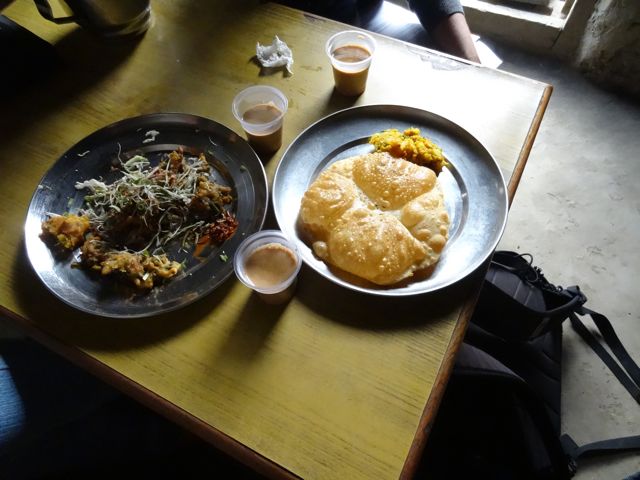 The heavenly Puri
The heavenly PuriI asked Leishembi where she learned to cook, assuming there had to be some secret reason why she was so very good at it. She explained that when she was a child, she used to help the Brahmin prepare the meals for special holidays. For example, in the Hindu tradition, when a baby is born the Brahmin in the neighborhood travels to the home of the newborn and cooks the meal for the family. Part of this tradition is that the girls in the house prepare all of the food that the Brahmin will then cook. Leishembi tells me she would not only prepare this food, but watch intently as the Brahmin cooked it, picking up hints and cooking skills here and there.
This passion for cooking clearly segued into her business and as a result Leishembi has been successful in her Tea Hotel endeavors. Not only did she change the dynamic of her own small community by providing a service that they all needed and wanted, but she also has attracted customers that would technically be in the locality to patronize a different tea hotel. She was able to, without effort, change the way the broader community thinks about where they get their food. People within certain localities are interacting with people from other localities simply because they want to come eat Leishembi’s food, specifically.
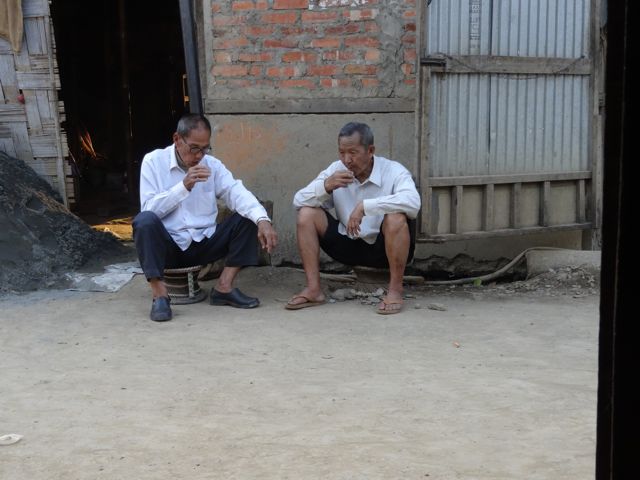 Grandpas need their tea, too!
Grandpas need their tea, too! That day in Imphal, talking to the Cluster Head, he said something that I think summarizes these stories nicely: “Microfinance is unlimited.” The way it changes lives isn’t just by building a business from scratch, expanding an existing business, or minimizing interest rates for an individual loan. It can help people to set an example, to change their lives outside of a business, or to engage a community. We want to spend time in the field because every time we go, we learn a new way that a life is being affected. We can see how those changes are leveraged to affect others. More than anything, it’s a reminder to us that what we do – what all of us do, borrowers, lenders, field workers, MFI staff, Fellows – is bigger than just ourselves.
PREVIOUS ARTICLE
Connecting Lenders and Borrowers: Memory, Kiva Coordinator Extraordinaire →NEXT ARTICLE
Office Space →













